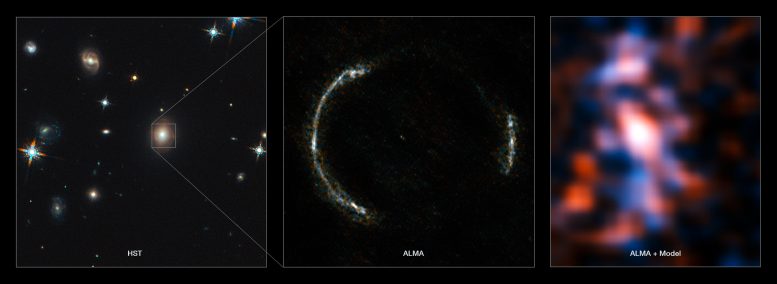
The left panel shows the foreground lensing galaxy (observed with Hubble), and the gravitationally lensed galaxy SDP.81, which forms an almost perfect Einstein Ring, is hardly visible. The middle image shows the sharp ALMA image of the Einstein ring, with the foreground lensing galaxy being invisible to ALMA. The resulting reconstructed image of the distant galaxy (right) using sophisticated models of the magnifying gravitational lens, reveal fine structures within the ring that have never been seen before: Several dust clouds within the galaxy, which are thought to be giant cold molecular clouds, the birthplaces of stars and planets. Credit: ALMA (NRAO/ESO/NAOJ)/Y. Tamura (The University of Tokyo)/Mark Swinbank (Durham University)
ALMA’s Long Baseline Campaign has revealed the sharpest image to date of star formation in the distant universe.
ALMA’s Long Baseline Campaign has produced a spectacular image of a distant galaxy being gravitationally lensed. The image shows a magnified view of the galaxy’s star-forming regions, the likes of which have never been seen before at this level of detail in a galaxy so remote. The new observations are far sharper than those made using the NASA/ESA Hubble Space Telescope, and reveal star-forming clumps in the galaxy equivalent to giant versions of the Orion Nebula in the Milky Way.
ALMA’s Long Baseline Campaign has produced some amazing observations, and gathered unprecedentedly detailed information about the inhabitants of the near and distant Universe. Observations made at the end of 2014 as part of the campaign targeted a distant galaxy called HATLAS J090311.6+003906, otherwise known as SDP.81. This light from this galaxy is a victim of a cosmic effect known as gravitational lensing. A large galaxy sitting between SDP.81 and ALMA[1] is acting as a lens, warping and magnifying the view of a more distant galaxy and creating a near-perfect example of a phenomenon known as an Einstein Ring.[2]
This schematic image shows how light from a distant galaxy is distorted by the gravitational effects of a foreground galaxy, which acts like a lens and makes the distant source appear distorted, but magnified, forming characteristic rings of light, known as Einstein rings. An analysis of the distortion of SDP.81 caused by this effect has revealed star-forming clumps of matter. Credit: ALMA (NRAO/ESO/NAOJ)/Luis Calçada (ESO)
At least seven groups of scientists have independently analyzed the ALMA data on SDP.81. This flurry of research papers has revealed unprecedented information about the galaxy, including details about its structure, contents, motion, and other physical characteristics.
ALMA acts as an interferometer. Simply speaking, the array’s multiple antennas work in perfect synchrony to collect light as an enormous virtual telescope.[3] As a result, these new images of SDP.81 have a resolution up to six times higher[4] than those taken in the infrared with the NASA/ESA Hubble Space Telescope.
The astronomers’ sophisticated models reveal fine, never-before-seen structure within SDP.81, in the form of dusty clouds thought to be giant repositories of cold molecular gas — the birthplaces of stars and planets. These models were able to correct for the distortion produced by the magnifying gravitational lens.
As a result, the ALMA observations are so sharp that researchers can see clumps of star formation in the galaxy down to a size of about 200 light-years, equivalent to observing giant versions of the Orion Nebula producing thousands of times more new stars at the far side of the Universe. This is the first time this phenomenon has been seen at such an enormous distance.
“The reconstructed ALMA image of the galaxy is spectacular,” says Rob Ivison, co-author of two of the papers and ESO’s Director for Science. “ALMA’s huge collecting area, the large separation of its antennas, and the stable atmosphere above the Atacama desert all lead to exquisite detail in both images and spectra. That means that we get very sensitive observations, as well as information about how the different parts of the galaxy are moving. We can study galaxies at the other end of the Universe as they merge and create huge numbers of stars. This is the kind of stuff that gets me up in the morning!”
This schematic image shows how light from a distant galaxy is distorted by the gravitational effects of a foreground galaxy, which acts like a lens and makes the distant source appear distorted, but magnified, forming characteristic rings of light, known as Einstein rings. An analysis of the distortion of SDP.81 caused by this effect has revealed star-forming clumps of matter. Credit: ALMA (NRAO/ESO/NAOJ)/Luis Calçada (ESO)
Using the spectral information gathered by ALMA, astronomers also measured how the distant galaxy rotates, and estimated its mass. The data showed that the gas in this galaxy is unstable; clumps of it are collapsing inwards, and will likely turn into new giant star-forming regions in the future.
Notably, the modeling of the lensing effect also indicates the existence of a supermassive black hole at the center of the foreground galaxy lens.[5] The central part of SDP.81 is too faint to be detected, leading to the conclusion that the foreground galaxy holds a supermassive black hole with more than 200–300 million times the mass of the Sun.
The number of papers published using this single ALMA dataset demonstrates the excitement generated by the potential of the array’s high resolution and light-gathering power. It also shows how ALMA will enable astronomers to make more discoveries in the years to come, also uncovering yet more questions about the nature of distant galaxies.
Notes
- The lensed galaxy is seen at a time when the Universe was only 15 percent of its current age, just 2.4 billion years after Big Bang. The light has taken over twice the age of the Earth to reach us (11.4 billion years), detouring along the way around a massive foreground galaxy that is comparatively close at four billion light-years away from us.
- Gravitational lenses were predicted by Albert Einstein as part of his theory of general relativity. His theory tells us that objects bend space and time. Any light approaching this curved space-time will itself follow the curvatures created by the object. This enables particularly massive objects — huge galaxies and galaxy clusters — to act as cosmic magnifying glasses. An Einstein ring is a special type of gravitational lens, in which the Earth, the foreground lensing galaxy, and the background lensed galaxy are in perfect alignment, creating a harmonious distortion in the form of a ring of light.
- ALMA’s ability to see the finest detail is achieved when the antennas are at their greatest separation, up to 15 kilometers apart. For comparison, earlier observations of gravitational lenses made with ALMA in a more compact configuration, with a separation of only around 500 meters, can be seen here.
- Details down to 0.023 arc-seconds, or 23 milli-arcseconds, can be measured in these data. Hubble observed this galaxy in the near-infrared, with a resolution of about 0.16 arc-seconds. Note, however, that when observing at shorter wavelengths, Hubble can reach finer resolutions, down to 0.022 arcseconds in the near-ultraviolet. ALMA’s resolution can be adjusted depending on the type of observations by moving the antennas further apart or closer together. For these observations, the widest separation was used, resulting in the finest resolution possible.
- The high-resolution ALMA image enables researchers to look for the central part of the background galaxy, which is expected to appear at the center of the Einstein ring. If the foreground galaxy has a supermassive black hole at the center, the central image becomes fainter. The faintness of the central image indicates how massive the black hole in the foreground galaxy is.
References:
“High-resolution ALMA observations of SDP.81. I. The innermost mass profile of the lensing elliptical galaxy probed by 30 milli-arcsecond images” by Yoichi Tamura, Masamune Oguri, Daisuke Iono, Bunyo Hatsukade, Yuichi Matsuda and Masao Hayashi, 8 June 2015, Publications of the Astronomical Society of Japan.
DOI: 10.1093/pasj/psv040
arXiv: 1503.07605
“Revealing the complex nature of the strong gravitationally lensed system H-ATLAS J090311.6+003906 using ALMA” by S. Dye, C. Furlanetto, A. M. Swinbank, C. Vlahakis, J. W. Nightingale, L. Dunne, S. A. Eales, Ian Smail, I. Oteo-Gomez, T. Hunter, M. Negrello, H. Dannerbauer, R. J. Ivison, R. Gavazzi, A. Cooray and P. van der Werf, 15 Jun3 2015, MNRAS.
DOI: 10.1093/mnras/stv1442
arXiv: 1503.08720
“ALMA maps the Star-Forming Regions in a Dense Gas Disk at z~3” by A. M. Swinbank, S. Dye, J. W. Nightingale, C. Furlanetto, Ian Smail, A. Cooray, H. Dannerbauer, L. Dunne, S. Eales, R. Gavazzi, T. Hunter, R. J. Ivison, M. Negrello, I. Oteo-Gomez, R. Smit, P. van der Werf and C. Vlahakis, 9 June 2015, The Astrophysical Journal Letters.
DOI: 10.1088/2041-8205/806/1/L17
arXiv: 1505.05148
“The Inner Mass Distribution of the Gravitational Lens SDP.81 from ALMA Observations” by Kenneth C. Wong, Sherry H. Suyu and Satoki Matsushita, 28 September 2015, The Astrophysical Journal.
DOI: 10.1088/0004-637X/811/2/115
arXiv: 1503.05558
“High-resolution ALMA Observations of SDP.81. II. Molecular Clump Properties of a Lensed Submillimeter Galaxy at z=3.042” by Bunyo Hatsukade, Yoichi Tamura, Daisuke Iono, Yuichi Matsuda, Masao Hayashi and Masamune Oguri, 24 July 2015, Publications of the Astronomical Society of Japan.
DOI: 10.1093/pasj/psv061
arXiv: 1503.07997
“ALMA Long Baseline Observations of the Strongly Lensed Submillimeter Galaxy HATLAS J090311.6+003906 at z=3.042” by ALMA Partnership, C. Vlahakis, T. R. Hunter, J. A. Hodge, L. M. Pérez, P. Andreani, C. L. Brogan, P. Cox, S. Martin, M. Zwaan, S. Matsushita, W. R. F. Dent, C. M. V. Impellizzeri, E. B. Fomalont, Y. Asaki, D. Barkats, R. E. Hills, A. Hirota, R. Kneissl, E. Liuzzo, R. Lucas, N. Marcelino, K. Nakanishi, N. Phillips, A. M. S. Richards, I. Toledo, R. Aladro, D. Broguiere, J. R. Cortes, P. C. Cortes, D. Espada, F. Galarza, D. Garcia-Appadoo, L. Guzman-Ramirez, A. S. Hales, E. M. Humphreys, T. Jung, S. Kameno, R. A. Laing, S. Leon, G. Marconi, A. Mignano, B. Nikolic, L.-A. Nyman, M. Radiszcz, A. Remijan, J. A. Rodón, T. Sawada, S. Takahashi, R. P. J. Tilanus, B. Vila Vilaro, L. C. Watson, T. Wiklind, Y. Ao, J. Di Francesco, B. Hatsukade, E. Hatziminaoglou, J. Mangum, Y. Matsuda, E. van Kampen, A. Wootten, I. de Gregorio-Monsalvo, G. Dumas, H. Francke, J. Gallardo, J. Garcia, S. Gonzalez, T. Hill, D. Iono, T. Kaminski, A. Karim, M. Krips, Y. Kurono, C. Lonsdale, C. Lopez, F. Morales, K. Plarre, L. Videla, E. Villard, J. E. Hibbard and K. Tatematsu, 14 July 2015, The Astrophysical Journal Letters.
DOI: 10.1088/2041-8205/808/1/L4
arXiv: 1503.02652
“ALMA imaging of SDP.81 – I. A pixelated reconstruction of the far-infrared continuum emission” by M. Rybak, J. P. McKean, S. Vegetti, P. Andreani and S. D. M. White, 20 May 2015, MNRAS Letters.
DOI: 10.1093/mnrasl/slv058
arXiv: 1503.02025
“ALMA imaging of SDP.81 – II. A pixelated reconstruction of the CO emission lines” by M. Rybak, S. Vegetti, J. P. McKean, P. Andreani and S. D. M. White, 12 August 201, MNRAS Letters.
DOI: h10.1093/mnrasl/slv092
arXiv: 1506.01425

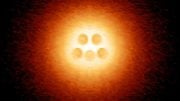

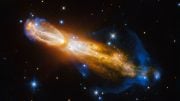


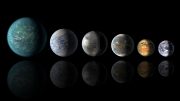
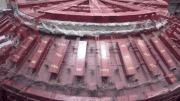

Be the first to comment on "ALMA Reveals Star Formation in the Distant Universe"